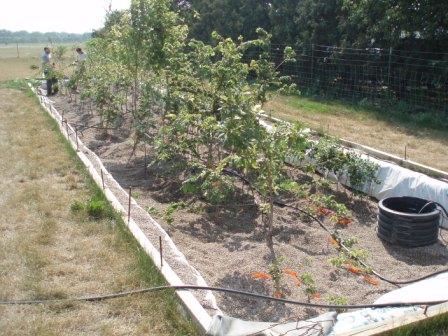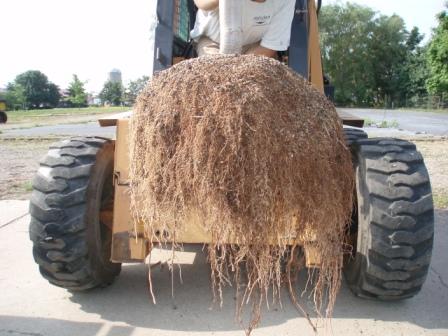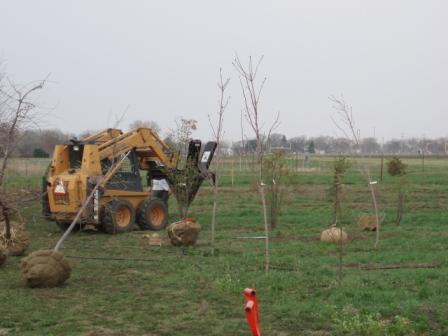For the past 11 years I’ve been running a nursery at the University of Minnesota called the TRE (for Teaching, Research, and Extension) nursery where we research all kinds of fun stuff like Dutch elm disease, the dangers of mulching, and what happens when you plant a tree too deeply. One of the most interesting things we’ve done recently, though, is to install Missouri gravel beds into the nursery. Missouri gravel beds are called Missouri gravel beds because they were invented by Chris Starbuck, a professor at Missouri State. He mostly works with gravel beds above the surface of the soil, while here at Minnesota we work with gravel beds below the surface of the soil (the gravel bed below is 60 feet by 10 feet and filled with about 2 feet of pea gravel — we do have a system for recirculating the water — which we sometimes use and sometimes don’t because of clogs, algae buildup, etc.).

We take bare root trees and place them into these beds in spring (when bare root trees are available from nurseries) to encourage root growth and then plant them out into the field later in the season. The amount of beautiful fine roots for transplanting is just incredible, and the resulting plant can be planted bare root any time of year, instead of just spring when bare root plants in our area are usually transplanted.


Now to be a little more specific: I’m a tremendous fan of planting bare root plants, but I’m not a fan of planting larger plants bare root (at least not without Missouri gravel bed treatment), particularly what are known as B&B trees — trees that are harvested and held in a burlap and wire cage, such as those being harvested below from our nursery.

The reason that I don’t like taking a B&B tree and planting it after bare rooting it (by removing all of the burlap as well as the wire cage and then washing off the soil that surrounds the roots) is that, no matter how gently you wash off the roots, fine roots tend to be destroyed. When you harvest a root ball for a larger tree you are removing about 80-90 % of the roots. The additional roots that you remove by washing the ball will often make the tree non-viable. This is something that have I learned from experience with individual trees, as well as from replicated experiments using hedge maples and Turkish filberts. We used trees with a stem diameter of about 2 inches with standard sized root balls for that size tree, washed off the root ball for half (five trees of each species) and planted the other half using our more standard system (we removed the top portion of the burlap and wire, but not the bottom portion so as not to disturb the ball). All of the trees which we bare rooted from B&B died after planting and all that we didn’t bare root lived. This is further supported by some research coming out of the University of Illinois earlier this year by Andrew Koeser (and coauthors) which shows that handling the balls of B&B trees just isn’t that good for them.
So why am I spending so much time with this? Simple, this is an area where researchers disagree. In fact, based on what Linda has written in the past I’ll bet that she disagrees with me. And that’s a good thing. People always want the quick and simple answer, but often there isn’t a quick and simple answer. I can’t deny that sometimes bare-rooting a B&B tree before planting might be a good thing. But I think that, in the majority of cases, it’s a mistake. In terms of containers — We’ve got a big research experiment going on that right now — we’ll have results next year.
Jeff, you should read the article I have in the recently published Landscape Below Ground from the ISA. I had a graduate student do work on this with Myrica and Thuja species. Not only did all of the bare-rooted plants survive, they had virtually the same root mass at the end of the study as the controls. As we know we lost numerous fine roots during transplant, this study demonstrates that plants can recover from this stress and in fact their root growth is stimulated by root pruning.
Unfortunately, the quality of B&B and containerized trees and shrubs is so uniformly poor that without bare rooting and corrective root pruning, trees will fail 5 or 10 or 15 years down the road. I did a study where we bare-rooted Pinus and Acer species and analyzed their roots. As I recall, the mugo pines showed over 90% fatal root flaws. (Need to publish this along with so many other projects!) Until the industry can produce trees with decent root systems, I and many other ISA certified arborists recommend either root washing (a technique that is regularly demonstrated at ISA conferences every year) or buying only bare root trees and avoiding the problems.
(If we EVER get the ability to post videos, powerpoints, etc. I'll post the one I use on this topic. Pictures help so much!)
Sorry, I still disagree. Thuja and Myrica are tough as nails — I don't work with Myrica much anymore, but if you go to http://www.jeffgillman.net/5.html you can see a picture of what we did to a set of Thuja in particular and still had them survive (we cut their roots into a box shape). I don't think you can generalize about other trees based on these species.
While I agree that there is certainly a lot of "trash" out there, there are also a lot of good trees produced by nurseries. The trick is to be able to differentiate one from the other — which I'll admit can be tough.
We published a study a few years ago that showed that root pruning of container grown trees — specifically willows and lindens — before they're planted actually doesn't stimulate root growth any more than not root pruning them does — this agrees with some older work by Mike Arnold.
What I think it comes down to is that much of this stuff is very species dependent.
Many comments! (1) Thuja "tough as nails?" It's the poster child for landscape failure out here. Poor roots + poor installation = dead arborvitae hedge. That's one of the reasons we selected it for the study. (2) If you can figure out a way to visualize the woody roots inside a container or B&B, you'll be a millonaire. Often there are no clues – otherwise, I'd never get stuck with some of the nightmares I've purchased!
(3) There also needs to be a practical differentiation made between production practices (your area) and landscape practices (mine). When you are planting one tree, you can spend extra time making sure to wash, prune and install properly. In a production nursery, it may not be feasible. I've done root washing and root pruning on hundreds of trees and shrubs of all different species and have only lost one (had an impossible root system that looked like a giant radish. It wouldn't have lived long regardless). (4) Next week I'll post pictures of one of my own trees – a Cercis – from which I removed easily 70% of the root system when I planted it 5 years ago. I certainly don't recommend this technique for a novice gardener, but many people have done this successfully.
(5) The certified arborists are the ones that get called to diagnose the problems of landscape trees I've mentioned earlier. That's why many of them are proponents of root washing and why the organization offers training on this technique.
I'll wait to see your pictures, while making one further point and asking a question. The point — Our root washing was extremely delicate and we still lost the trees — and it wasn't for lack of proper planting, irrigation or care, we wanted those trees to live (I'd just read Bonnie Appleton's article when we worked with the Turkish filberts, the hedge maples were an earlier test). And my question — What size trees were you dealing with? I would expect trees like ash, poplar, willow, and redbuds, to do fine with a washing of their roots if they were a couple of inches in caliper or smaller. And smaller trees of many other species might do fine. But despite many tries I just haven't seen many larger trees do well (though there are certainly exceptions — trees held B&B for long periods of time often develop many fine roots and can then be washed and planted — but I'd consider that the exception to the rule).
I think the largest I've done was maybe 3" caliper? And seasonality is an important consideration – best success is in the late fall/early winter out here, because of our droughty summers. But I've also done it in April (the Cercis is a case in point). Finally, I should point out that most of our B&Bs come from Oregon in their wonderful Willamette Valley heavy soils. Planting these clay balls in the sandy soils of Spokane, for instance, resulted in high tree failure until the City of Spokane went to root washing. I think they have a 97% survival rate now, and it's actually cheaper in terms of labor than the old way. I'm going to try to get Jim Flott, the former city arborist, to weigh in as well. He may have been doing root washing of B&B longer than anyone I know.
I could certainly see the differences in soil type that you mention having a huge effect on transplant — and on fine root production. Really heavy clay soil during production at the nursery can cause a proliferation of fine roots closer to the trees trunk (meaning that, perhaps, it could be washed and have more roots remaining). Also, I thought this article that I just found might be interesting http://www.indiana-arborist.org/documents/pdf/BareRoottoBareRoot-ProceedingsPaper.pdf
It does a good job of pointing out some of the intricacies of bare-rooting.
Wow, my knowledge of tree root care and handling just tripled. Great discussion!
I have found this discussion very interesting as well. I have done this int he past with trees that I have planted and had to remove. I am usually able to get them to recover. I'll be an avid reader of future posts.
I'm just getting into the bare root and root washing research. Do you have any bibliography? Authors, websites, any materials would be appreciated. Thanks.
I'm just getting into the bare root and root washing research. Do you have any bibliography? Authors, websites, any materials would be appreciated. Thanks.
I have 20 baby katsura trees and I think the gravel bed sounds great I would like to make a bed but should I plant them during the summer or the fall? They are in pots now.
Kristin, I would wait until fall – transplanting in the summer is stressful with higher temperatures and high leaf transpiration. When they're dormant (no leaves) they won't be hit as hard.
Hi all, I am in subtropical/warm temperate Australia. I have a number of 15y+ tropical fruit trees in large containers (I rent so it’s my only option). I am hoping to buy a property this year and being they are very precious to me, I am doing my research into the best, modern planting techniques to suit my specific conditions. So far much of the discussion I have seen around root washing & pruning refers to deciduous trees (e.g. waiting for dormancy to plant) and I am wondering if you can point me to similar resources for tropical evergreens, which in my climate do not have pronounced and reliable periods of dormancy or slowed growth. I have tried root washing and pruning of my citrus with great success but they are not as difficult to replace as some of the others so I was braver 🙂 Perhaps the gravel bed as an intermeiate step may be a worthwhile consideration?
Hi Kathy –
First, my apologies for my late reply. The pandemic really threw my schedule off and I have been struggling with increased demands for my assistance.
You can root wash anything, including evergreens. You need to be aware that water demands for the foliage will be higher, so keeping the root zone hydrated is critical. Just try to do this during the cool/wet season and the stress will be reduced on the tree during establishment.